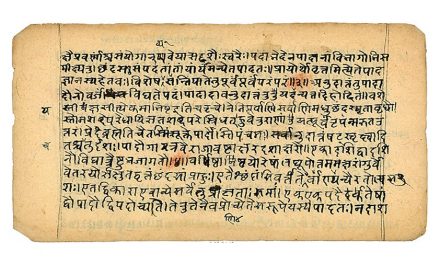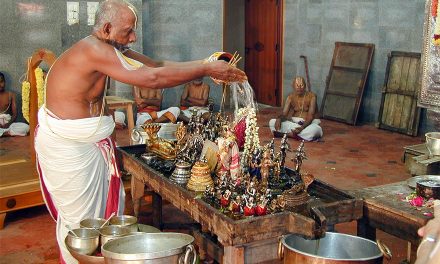Recently a team comprised of delegates from the National Mission for Manuscripts and National Informatics Centre visited Majuli islands in Assam to attend a state level workshop on ‘Manuscriptology & Preventive Conservation’. The purpose of the visit was to assess the ground realities for launching a digitization program of manuscripts kept in satras. Majuli has been an important religious and cultural hot spot of Assam for nearly five hundred years and a storehouse of a large number of manuscripts. The frequency and the overwhelming nature of floods in Assam as well as the insurgency factor make it important and at the same time difficult to save these rich cultural inheritances.
The Islands
Majuli has supposedly derived its name from its location between the two streams of Brahmaputra, Lohit and Kherkatia Suti. Acknowledged as the largest inhabited river island of the world, it falls in the Jorhat district of Assam. Before 1950, the total area of Majuli was one thousand two hundred and fifty six square kilometers. However, continuous erosion has resulted in the depletion of its size to nine hundred square kilometers currently. It is a unique exhibition of nature’s wrath and rapture.
Majuli boasts of a number of wetlands to which migratory birds flock in large numbers. In fact, isolation from the mainland has helped in the protection and preservation of some very rare species of birds. Endangered storks and innumerable migratory birds visit Majuli in the winter season and it has been declared as an Important Bird Area (IBA) by the Government of India. It also boasts of more than one hundred wetlands or beels, more than twenty species of mammals, nearly ten types of amphibians and more than one hundred types of local fish, including sixty five varieties of ornamental fish. In flora, there are more than one thousand species of trees, grasses, creepers, flowers, orchids, ferns and other forms of plants are found. Sufficient rain and humidity endow Majuli with evergreen and deciduous forests.
Emergence of a Distinctive Cultural Identity
As fascinating as its biological diversity is, the cultural make-up of the island of Majuli is no less deserving of attention. A nerve-centre of the neo-Vaishnavite religion, art and culture, Majulihas been influenced and moulded by the Satriya culture. This may be witnessed in the degree of influence that the historical property of the satras – the antiques, manuscripts, relics etc. – have exercised on its inhabitants.
To trace the roots of this development, one must step back to the sixteenth century when Mahapurush Srimanta Sankardev and his chief disciple, Madhabdev, laid the foundation of satriya culture in Majuli and ushered in an era with a distinctive religio-cultural flavour. Sankardev, the great social reformer, founded a new cult of Vaishnavism known as ‘Ek Sarania’ (devotion to sole Almighty). He believed that Vishnu or Krishna is the Supreme Lord and He is to be worshipped only through naam prasanga – prayers; choidhya prasanga or fourteen prayers; gayanbayanor playing of drum and cymbals; borgeet or devotional songs and bhaona or theatrical performances. These are some of the mediums to chant the glory of God. The satras situated here are the centers of religious, cultural and social life of the people of Assam and are important pilgrimage centers for Vaishnavites and others.
Satras
The Belguri Satra, the first satra to be established in Majuli, was named after the place where Sankardev and Madhabdev met for the first time. That meeting was followed by the establishment of satras and the rising religious prominence of Majuli in Assam. The followers of Sankardev and Madhabdev established sixty-four satras in the sixteenth and seventeenth centuries, practicing and propagating Vaishnavism as preached by them. Of the sixty-four satras which were established there, only twenty-two are inexistence at present. The rest have either been eroded away or have been shifted to other places.
In terms of functioning, satras resemble Buddhist monasteries where a number of inmates, called bhaktas, dedicate themselves to religious activities. In each satra, there is a satradhikari or the head of the satra and a dekasatradhikari or the deputy head of the satra. Both these office-bearers reside within the satra campus. A model satra has a naamghar or prayer hall, the monikeet or the sanctum sanctorum and four hatisor rows of cottages for the inmates arranged in a rectangular or square form.
Sanchi Pat: Assamese Manuscripts
Every satra has its own collection of manuscripts, the numbers range from ten to three hundred and fifty in different satras and a total of around four thousand manuscripts between them. Most of these are original texts written by Sankardev and Madhabdev. The most popular themes are religion (mainly concerned with the worship of Lord Krishna), medicine, astrology and zoology. Almost all manuscripts are written on Sanchi Pat or the bark of a tree.
The satras also house rare collections of illustrated manuscripts. The most important manuscripts preserved at the satras include Hasti Vidyarnava, a treatise on elephants (Auniati Satra); illustrated Bhagawat and the Nidana, a manuscript on etiology (Bengenaati Satra); Tantrasar, a manuscript about rituals of worship; Charit-Puthi, a biographical manuscript on saints and Purana, Hindu scripture (Dakhimpat Satra); Nam-Malika, Ratnawali, a scripture written by Madhabdev, and Dasama a scripture written by Sankardev (Uttar Kamalabari Satra).
Living Manuscript Traditions
One interesting fact about these satras is that the head priest worships the manuscripts twice every day – once in the morning and once in the evening, for one hour each. It is considered a tribute to the Lord. Although one notes the presence of Deities in the main temple complex, it is the manuscripts that are worshipped. We were privileged to be allowed to witness this activity at Auniati Satra. The priest starts the worship by paying his tribute to the manuscript by bowing his head down and then, opening the manuscript, starts reading from where he had left earlier. It is customary to read the manuscript in the light of a mustard oil lamp. Upon completion of the day’s reading, a bookmark is placed to indicate the start of next day’s reading. He again pays homage to the manuscript and then wraps it up. The manuscript that is worshipped is a copy of the original which is kept in a box in the praying room or a ‘brass sarai’. They do not take the manuscript out of the box. For conservation purposes they change the cloth of the manuscript from time to time and this is also done by the head priest behind closed doors.
Uncertain Future
The current situation at Majuli, pervaded as it is by fear of militant activities, is not the most optimistic. There are clearly many hurdles posed by the perpetual threat of violence, the continuing erosion of the island and the prevalent inclement weather.
First-hand observation of all of the above has only made us more determined to start the digitization work as early as possible. Immediate plans include providing support to the satras for the upkeep of manuscripts, to impart training for the conservation of manuscripts (basic level training) and setting up of technological and logistical support for digitization.












